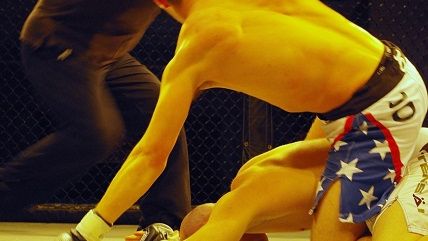UFC: One Man's Brutal Spectacle Is Another's Eden
People have a right to do what they want with their own bodies.

If you see a man lying on his back while another man crouches over him, punching him in the face repeatedly, it's natural to assume the man on his back is losing the fight and losing it badly. But in the UFC, that assumption can prove woefully off base. The next thing you know, the man on his back might have grabbed the other man's wrist or ankle and twisted his arm or leg in a direction never intended by God or human anatomy, and the man who had been doing the punching is suddenly tapping out—i.e., slapping the mat and conceding the fight.
The UFC, for those of you who just woke up from a 20-year nap, is the Ultimate Fighting Championship: the nation's leading mixed-martial-arts (MMA) promotional organization. Sixteen years ago, two casino investors named Frank and Lorenzo Fertitta bought the young UFC for $2 million. Last year the organization brought in $600 million in revenue, and last week the talent conglomerate WME-IMG bought it for $4 billion.
MMA has come a long way since its early days, when Sen. John McCain (R-Ariz.) condemned it as "human cockfighting" and lawmakers in New York banned it outright. When it first began, it seemed like the result of a beery dorm-room debate over who would win in a fight: a boxer or a wrestler? A judo master or a karate black belt?
There were no weight classes, and only a handful of rules: biting and eye-gouging were forbidden, but strikes to the groin were not. One of the earlier matches pitted Brazilian jiu-jitsu phenomenon Royce Gracie, at 176 pounds, against Akebono, a 500-pound sumo wrestler. Gracie won lying on his back with Akebono on top of him, in the first round, by forcing Akebono to submit with a shoulder lock.
The sport has matured considerably since those circus side-show days. The competitors today are more well-rounded: Even a kickboxer will have some grappling skills; even a wrestler will have learned how to throw a punch. The UFC also has weight divisions now, and a few more rules—but not many. (A knee-strike to a downed opponent's face is not allowed, for example, but a knee-strike to his torso is.)
It also has a women's division, which includes Ronda Rousey—the once-unstoppable bantamweight who has appeared on the cover of Sports Illustrated and in several movies. Rousey is one reason UFC president Dana White, who once said women would never fight in the league, is very happy he changed his mind.
For those who grew up with boxing, MMA can take some getting used to. When a boxer gets knocked to the canvas, his opponent steps back and politely waits while the referee counts and the downed man tries to get to his feet. When an MMA fighter gets knocked to the canvas, his opponent jumps on top of him and starts pounding.
That might seem unsportsmanlike, except—as previously noted—an MMA fighter on the ground can be even more dangerous than one on his feet. This is why many fighters will "pull guard," which entails grabbing your opponent, wrapping your legs around his waist, and falling backward, pulling the other man down on top of you.
Besides, if there is one thing MMA does not lack, it is sportsmanship. It's common to see two competitors who have beaten each other bloody stop at the final buzzer, hug, grin, and congratulate each other for the excellent fight.
But sportsmanship does not rule out rivalries, some of which—such as those between middleweight Anderson Silva and light heavyweight Chael Sonnen, or between light heavyweights Jon Jones and Daniel Cormier—have been intense.
There are, of course, those who think that MMA is nothing but a "brutal, money-making spectacle" that should be banned. Similar arguments have surrounded boxing for decades.
It's true that both sports can be dangerous, and even fatal. But no more so than many other sports: An average of 38 people die every year skiing or snowboarding, for instance, and in 2014 more than 700 people died riding bicycles. That same year, more than 52,000 people were injured playing volleyball, and another 34,000 were hurt from gymnastics—which is 4,000 more than the roughly 30,000 people who got hurt from engaging in martial arts.
Comparisons based on such statistics miss the mark, however, because we can't ban the most dangerous sport without banning all sports. Ban gymnastics, and cheerleading becomes the most dangerous. Ban cheerleading, and wrestling becomes the most dangerous—and so on.
More important, however, is the question of personal autonomy: People have a right to do what they want with their own bodies. Unlike actual cockfighting, participation in MMA—not to mention downhill skiing and bicycling—is voluntary.
Some might argue that society should protect people from their own poor choices, because it is "for their own good." But that depends on whose definition of "good" you use.
As James K. Hammitt, director of the Center for Risk Analysis at Harvard, told The New York Times a few years ago, "a 'pure' altruist cares about others' well-being as whatever they define it to be. A 'paternalistic' altruist cares only about some aspect of other people's well-being, like their health."
Pure altruism seems the more preferable route, both in the abstract and in practice. Society isn't going to ban everything that is dangerous in any way, so it has to permit some dangerous activities.
Where does it draw the line? Everyone will have his or her own answer. Since that is the case, it seems that the person most qualified to decide what level of danger is right for Mr. Jones is pretty clear: Mr. Jones himself.
This column originally appeared at the Richmond Times-Dispatch.


Show Comments (26)